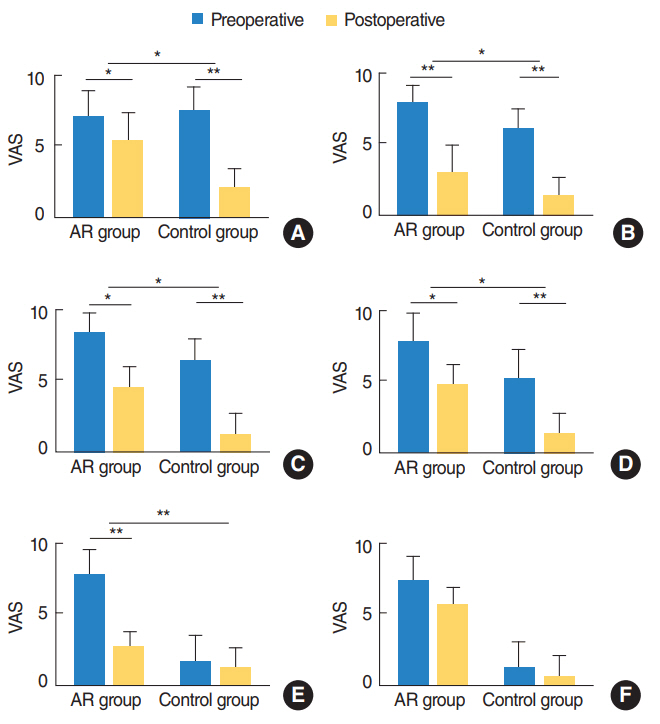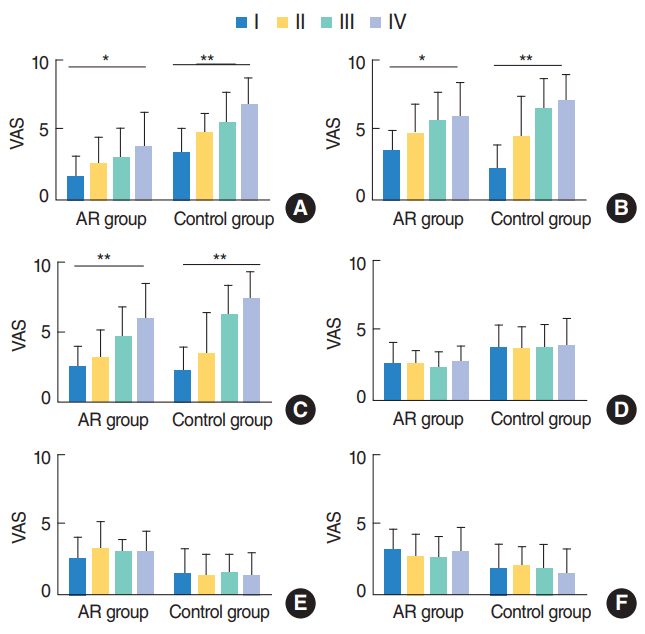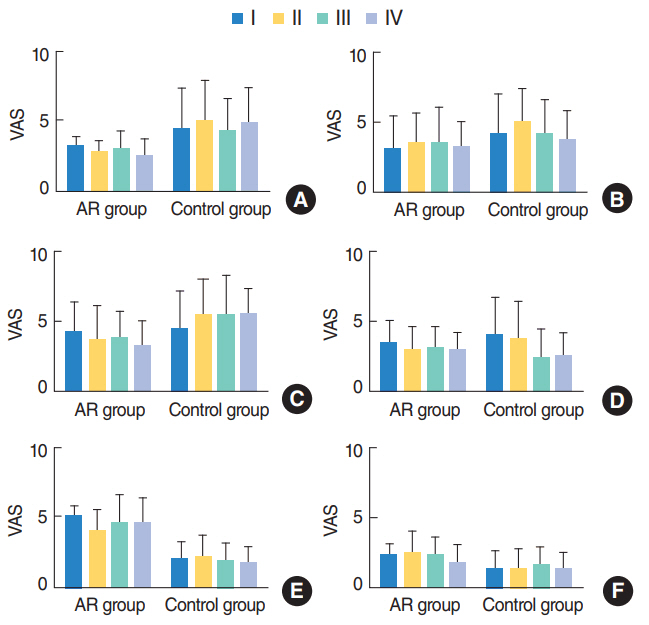Clin Exp Otorhinolaryngol.
2018 Mar;11(1):52-57. 10.21053/ceo.2017.00500.
The Impact of Allergic Rhinitis on Symptom Improvement in Pediatric Patients After Adenotonsillectomy
- Affiliations
-
- 1Department of Otorhinolaryngology, Dankook University College of Medicine, Cheonan, Korea. jihunmo@gmail.com
- KMID: 2407793
- DOI: http://doi.org/10.21053/ceo.2017.00500
Abstract
OBJECTIVES
It is well known that allergic rhinitis (AR) has positive association with adenotonsillectomy. However, the impact of AR on symptom improvement after adenotonsillectomy is not well documented. Hence, we aimed to evaluate the effect of AR on the symptom improvement after adenotonsillectomy between AR and nonallergic patients.
METHODS
A retrospective analysis was performed on 250 pediatric patients younger than 10 years old who received adenotonsillectomy from June 2009 to June 2014 in a tertiary referral hospital. All patients underwent skin prick test or multiple allergen simultaneous test (MAST) before surgery and classified into AR group and control group. Obstructive and rhinitis symptoms including snoring, mouth breathing, nasal obstruction, rhinorrhea, itching, and sneezing were evaluated before and 1 year after surgery using questionnaire and telephone survey.
RESULTS
AR group was 131 and control group was 119, showing higher prevalence (52.4%) of AR among adenotonsillectomized patients. Both groups showed dramatic improvement of symptoms such as snoring and mouth breathing after surgery (all P < 0.05). However, AR group showed significantly less improvement than control group in snoring, mouth breathing, nasal obstruction, and rhinorrhea (all P < 0.05). Multivariate analysis showed that preoperative mouth breathing and snoring were dependent on tonsil grade and postoperative symptoms were mainly dependent on presence of AR. Nasal obstruction was dependent on tonsil grade and presence of AR preoperatively and presence of AR postoperatively. These suggest the importance of AR as a risk factor for mouth breathing, snoring, and nasal obstruction.
CONCLUSION
AR has positive association with adenotonsillectomy and not only allergic symptoms but also obstructive symptoms such as snoring and mouth breathing improved less in AR group than control group. Hence, patients with AR should be monitored for long-term basis and more carefully after adenotonsillectomy.
Keyword
MeSH Terms
Figure
Cited by 2 articles
-
Strain-Specific Differences in House Dust Mite (
Dermatophagoides farinae
Ki-Il Lee, Jun-Sang Bae, Eun Hee Kim, Ji Hye Kim, Lele Lyu, Young-Jun Chung, Ji-Hun Mo
Clin Exp Otorhinolaryngol. 2020;13(4):396-406. doi: 10.21053/ceo.2019.01837.Cluster Analysis of Inhalant Allergens in South Korea: A Computational Model of Allergic Sensitization
Dong-Kyu Kim, Young-Sun Park, Kyung-Joon Cha, Daeil Jang, Seungho Ryu, Kyung Rae Kim, Sang-Heon Kim, Ho Joo Yoon, Seok Hyun Cho
Clin Exp Otorhinolaryngol. 2021;14(1):93-99. doi: 10.21053/ceo.2019.01921.
Reference
-
1. Mitchell RB. Adenotonsillectomy for obstructive sleep apnea in children: outcome evaluated by pre- and postoperative polysomnography. Laryngoscope. 2007; Oct. 117(10):1844–54.
Article2. Mitchell RB, Kelly J, Call E, Yao N. Long-term changes in quality of life after surgery for pediatric obstructive sleep apnea. Arch Otolaryngol Head Neck Surg. 2004; Apr. 130(4):409–12.
Article3. Mitchell RB, Kelly J, Call E, Yao N. Quality of life after adenotonsillectomy for obstructive sleep apnea in children. Arch Otolaryngol Head Neck Surg. 2004; Feb. 130(2):190–4.
Article4. Sadeghi-Shabestari M, Jabbari Moghaddam Y, Ghaharri H. Is there any correlation between allergy and adenotonsillar tissue hypertrophy. Int J Pediatr Otorhinolaryngol. 2011; Apr. 75(4):589–91.
Article5. Friedman M, Ibrahim H, Joseph NJ. Staging of obstructive sleep apnea/hypopnea syndrome: a guide to appropriate treatment. Laryngoscope. 2004; Mar. 114(3):454–9.
Article6. Kemaloglu YK, Goksu N, Inal E, Akyildiz N. Radiographic evaluation of children with nasopharyngeal obstruction due to the adenoid. Ann Otol Rhinol Laryngol. 1999; Jan. 108(1):67–72.
Article7. Chung YJ, Cho IK, Lee KI, Bae SH, Lee JW, Chung PS, et al. Seasonal specificity of seasonal allergens and validation of the ARIA classification in Korea. Allergy Asthma Immunol Res. 2013; Mar. 5(2):75–80.
Article8. Han M, Shin S, Park H, Park KU, Park MH, Song EY. Comparison of three multiple allergen simultaneous tests: RIDA allergy screen, MAST optigen, and polycheck allergy. Biomed Res Int. 2013; 2013:340513.
Article9. Baldassari CM, Mitchell RB, Schubert C, Rudnick EF. Pediatric obstructive sleep apnea and quality of life: a meta-analysis. Otolaryngol Head Neck Surg. 2008; Mar. 138(3):265–73.
Article10. Friedman M, Wilson M, Lin HC, Chang HW. Updated systematic review of tonsillectomy and adenoidectomy for treatment of pediatric obstructive sleep apnea/hypopnea syndrome. Otolaryngol Head Neck Surg. 2009; Jun. 140(6):800–8.
Article11. Bhattacharjee R, Kheirandish-Gozal L, Spruyt K, Mitchell RB, Promchiarak J, Simakajornboon N, et al. Adenotonsillectomy outcomes in treatment of obstructive sleep apnea in children: a multicenter retrospective study. Am J Respir Crit Care Med. 2010; Sep. 182(5):676–83.12. Tasker C, Crosby JH, Stradling JR. Evidence for persistence of upper airway narrowing during sleep, 12 years after adenotonsillectomy. Arch Dis Child. 2002; Jan. 86(1):34–7.
Article13. Vargervik K, Miller AJ, Chierici G, Harvold E, Tomer BS. Morphologic response to changes in neuromuscular patterns experimentally induced by altered modes of respiration. Am J Orthod. 1984; Feb. 85(2):115–24.
Article14. Wright AL, Holberg CJ, Martinez FD, Halonen M, Morgan W, Taussig LM. Epidemiology of physician-diagnosed allergic rhinitis in childhood. Pediatrics. 1994; Dec. 94(6 Pt 1):895–901.
Article15. Bresolin D, Shapiro PA, Shapiro GG, Chapko MK, Dassel S. Mouth breathing in allergic children: its relationship to dentofacial development. Am J Orthod. 1983; Apr. 83(4):334–40.
Article16. Linder-Aronson S. Adenoids: their effect on mode of breathing and nasal airflow and their relationship to characteristics of the facial skeleton and the denition: a biometric, rhino-manometric and cephalometro-radiographic study on children with and without adenoids. Acta Otolaryngol Suppl. 1970; 265:1–132.17. Kim DK, Han DH. Impact of allergic rhinitis on quality of life after adenotonsillectomy for pediatric sleep-disordered breathing. Int Forum Allergy Rhinol. 2015; Aug. 5(8):741–6.
Article18. Lee CH, Kang KT, Weng WC, Lee PL, Hsu WC. Quality of life after adenotonsillectomy for children with sleep-disordered breathing: a linear mixed model analysis. Int J Pediatr Otorhinolaryngol. 2014; Aug. 78(8):1374–80.
Article




